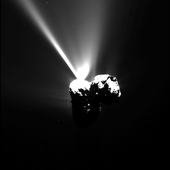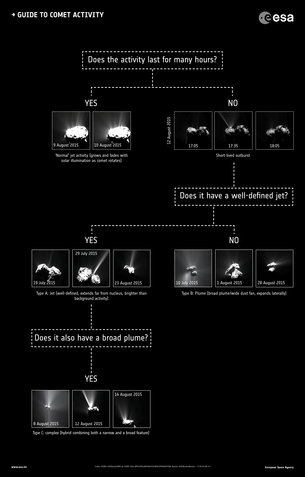Summer fireworks on Rosetta’s comet
23 September 2016 Brief but powerful outbursts seen from Comet 67P/Churyumov–Gerasimenko during its most active period last year have been traced back to their origins on the surface.
In the three months centred around the comet’s closest approach to the Sun, on 13 August 2015, Rosetta’s cameras captured 34 outbursts.
These violent events were over and above regular jets and flows of material seen streaming from the comet’s nucleus. The latter switch on and off with clockwork repeatability from one comet rotation to the next, synchronised with the rise and fall of the Sun’s illumination.
By contrast, outbursts are much brighter than the usual jets – sudden, brief, high-speed releases of dust. They are typically seen only in a single image, indicating that they have a lifetime shorter than interval between images – typically 5–30 minutes.
A typical outburst is thought to release 60–260 tonnes of material in those few minutes.
On average, the outbursts around the closest approach to the Sun occurred once every 30 hours – about 2.4 comet rotations. Based on the appearance of the dust flow, they can be divided into three categories.
One type is associated with a long, narrow jet extending far from the nucleus, while the second involves a broad, wide base that expands more laterally. The third category is a complex hybrid of the other two.
“As any given outburst is short-lived and only captured in one image, we can’t tell whether it was imaged shortly after the outburst started, or later in the process,” notes Jean-Baptiste Vincent, lead author of the paper published today in Monthly Notices of the Astronomical Society.
“As a result, we can’t tell if these three types of plume ‘shapes’ correspond to different mechanisms, or just different stages of a single process.
"But if just one process is involved, then the logical evolutionary sequence is that an initially long narrow jet with dust is ejected at high speed, most likely from a confined space.
"Then, as the local surface around the exit point is modified, a larger fraction of fresh material is exposed, broadening the plume ‘base’.
"Finally, when the source region has been altered so much as not to be able to support the narrow jet anymore, only a broad plume survives.”
The other key question is how these outbursts are triggered.
The team found that just over half of the events occurred in regions corresponding to early morning, as the Sun began warming up the surface after many hours in darkness.
The rapid change in local temperature is thought to trigger thermal stresses in the surface that might lead to a sudden fracturing and exposure of volatile material. This material rapidly heats up and vaporises explosively.
These outbursts are attributed to a different cause, where the cumulative heat makes its down to pockets of ‘volatiles’ buried beneath the surface, again causing sudden heating and an explosion.
“The fact that we have clear morning and noon outbursts points to at least two different ways of triggering an outburst,” says Jean-Baptiste.
But it is also possible that yet another cause is involved in some outbursts.
“We found that most of the outbursts seem to originate from regional boundaries on the comet, places where there are changes in texture or topography in the local terrain, such as steep cliffs, pits or alcoves,” adds Jean-Baptiste.
Indeed, the fact that boulders or other debris are also seen around the regions identified as the sources of the outbursts confirms that these areas are particularly susceptible to erosion.
While slowly eroding cliff faces are thought to be responsible for some of the regular, long-lived jet features, a weakened cliff edge may also suddenly collapse at any time, night or day. This collapse would reveal substantial amounts of fresh material and could lead to an outburst even when the region is not exposed to sunlight.
At least one of the events studied took place in local darkness and may be linked to cliff collapse.
“Studying the comet over a long period of time has given us the chance to look into the difference between ‘normal’ activity and short-lived outbursts, and how these outbursts may be triggered,” says Matt Taylor, ESA’s Rosetta project scientist.
“Studying how these phenomena vary as the comet progresses along its orbit around the Sun give us new insight into how comets evolve during their lifetimes.”
Notes for Editors
“Summer fireworks on Comet 67P,” by J.-B. Vincent et al is accepted for publication in Monthly Notices of the Royal Astronomical Society.
This article also uses information from “Are fractured cliffs the source of cometary dust jets? Insights from OSIRIS/Rosetta at 67P,” by J.-B. Vincent et al, published in Astronomy & Astrophysics 2015
Of the 34 outbursts, 26 were detected with the OSIRIS narrow-angle camera, three with the OSIRIS wide-angle camera, and five with the Navigation Camera.
For further information, please contact:
Jean-Baptiste Vincent
Max Planck Institute for Solar System Research, Gottingen, Germany
Email: vincent@mps.mpg.de
Matt Taylor
ESA Rosetta project scientist
Email: matt.taylor@esa.int
Markus Bauer
ESA Science and Robotic Exploration Communication Officer
Tel: +31 71 565 6799
Mob: +31 61 594 3 954
Email: markus.bauer@esa.int
Related articles

Rosetta captures comet outburst25 August 2016

Rosetta's big day in the Sun13 August 2015

Comet’s firework display ahead of perihelion11 August 2015
VERSIÓN EN ESPAÑOL :
Fuegos artificiales en el verano del cometa
23 septiembre 2016
Las breves pero potentes emisiones vistas en 67P/Churyumov-Gerasimenko durante su periodo de mayor actividad el año pasado han sido analizadas hasta dar con su origen en la superficie del cometa.
En los tres meses alrededor del 13 de agosto de 2015, fecha del máximo acercamiento del cometa al Sol, las cámaras de Rosetta capturaron 34 emisiones.
Estos violentos estallidos iban mucho más allá de los chorros y flujos de materia que suelen salir expulsados del núcleo del cometa. Estos aparecen y desaparecen con precisión cronométrica en cada rotación, sincronizándose con la salida y la puesta del Sol en el cometa.
Por el contrario, las emisiones son mucho más brillantes que los chorros; se trata de breves proyecciones de polvo a alta velocidad. Normalmente solo se llegan a verse en una imagen, lo que indica que su duración es inferior al intervalo de captura, que es de entre 5 y 30 minutos.
Se cree que, en esos pocos minutos, cada emisión puede liberar entre 60 y 260 toneladas de materia.
De media, las emisiones alrededor del máximo acercamiento al Sol se produjeron una vez cada 30 horas, cada 2,4 rotaciones del cometa. Basándonos en la aspecto del flujo de polvo, podemos dividir las emisiones en tres categorías:
La primera se asocia a un chorro largo y estrecho, que se va alejando del núcleo. El segundo tipo de emisión implica una base ancha que se expande más hacia los lados. La tercera categoría muestra un complejo híbrido de los dos tipos anteriores.
“Como las emisiones son tan cortas que solo se capturan en una imagen, no podemos afirmar si una determinada imagen se capturó poco después de comenzar la emisión o más tarde en el proceso —explica Jean-Baptiste Vincent, autor principal del artículo publicado hoy en Monthly Notices of the Astronomical Society—. Así, no podemos saber si estos tres tipos de columna corresponden a distintos mecanismos o si se trata de distintas etapas de un único proceso”.
“No obstante, si se trata de un solo proceso, la secuencia evolutiva lógica sería que un chorro largo y estrecho de polvo se expulsa a alta velocidad, probablemente desde un espacio confinado.
“Después, a medida que cambia la superficie alrededor del punto de partida, un área mayor de materia nueva queda expuesta, ampliándose la ‘base’ de la columna”.
“Finalmente, cuando la región de origen se ha visto alterada hasta el punto de no poder soportar más el chorro, lo único que sobrevive es esa columna más ancha”.
La otra cuestión clave es qué origina estas emisiones.
El equipo descubrió que algo más de la mitad de estos eventos se producían en regiones correspondientes a la primera hora de la mañana, cuando el Sol comenzaba a calentar la superficie tras varias horas de oscuridad.
Así, se cree que el rápido cambio de la temperatura local provoca unas tensiones térmicas en la superficie que podrían llevar a la fracturación y exposición repentinas de materia volátil. Esta materia se calentaría con rapidez y terminaría por evaporarse de forma explosiva.
El resto de eventos se produjo tras el mediodía local, cuando la superficie había permanecido iluminada varias horas.
Estas emisiones se atribuyen a otra causa: el calor acumulado llegaría a bolsas de componentes volátiles enterrados bajo la superficie, provocando una vez más su calentamiento y estallido repentinos.
“El hecho de que existan puntos de emisión evidentes en la mañana y el mediodía indica, como mínimo, dos desencadenantes distintos para las emisiones”, reconoce Jean-Baptiste.
Pero también es posible que algunas emisiones tengan otra causa.
“Hemos visto que la mayoría de emisiones parecen originarse en los límites regionales del cometa, lugares con cambios en la textura o topografía del terreno local, como acantilados, fosas o nichos”, añade.
Efectivamente, el hecho de que también se aprecien rocas y otros residuos alrededor de estas regiones, identificadas como fuentes de las emisiones, confirma que estas áreas son especialmente susceptibles a la erosión.
Aunque se cree que la lenta erosión de la caras de los acantilados es responsable de algunos de los chorros regulares y más prolongados, el debilitamiento de una de estas paredes también podría provocar su derrumbamiento repentino, de noche o de día. Este derrumbamiento expondría cantidades sustanciales de materia nueva, lo que podría provocar una emisión aunque la región no estuviese expuesta a la luz solar.
Al menos uno de los eventos estudiados se produjo en la oscuridad, y podría deberse al derrumbamiento de uno de estos precipicios.
“El estudio prolongado del cometa nos ha permitido observar la diferencia entre la actividad ‘normal’ y las emisiones de corta duración, así como sus posibles desencadenantes”, aclara Matt Taylor, científico del proyecto Rosetta de la ESA.
“Al analizar cómo estos fenómenos varían a medida que el cometa recorre su órbita alrededor del Sol obtenemos nuevos datos sobre la evolución de los cometas a lo largo de su vida”.
Nota para los editores
“Summer fireworks on Comet 67P”, de J.-B. Vincent et al., está publicado en Monthly Notices of the Royal Astronomical Society.
El presente documento también utiliza información procedente de “Are fractured cliffs the source of cometary dust jets? Insights from OSIRIS/Rosetta at 67P”, de J.-B. Vincent et al., publicado en Astronomy & Astrophysics en 2015.
De las 34 emisiones, 26 fueron detectadas con el teleobjetivo de OSIRIS, tres con la cámara de gran angular y otras cinco con la cámara de navegación
Para más información:
Jean-Baptiste Vincent
Max Planck Institute for Solar System Research, Gottingen, Alemania
Correo electrónico: vincent@mps.mpg.de
Jean-Baptiste Vincent
Max Planck Institute for Solar System Research, Gottingen, Alemania
Correo electrónico: vincent@mps.mpg.de
Matt Taylor
ESA Rosetta project scientist
Correo electrónico: matt.taylor@esa.int
ESA Rosetta project scientist
Correo electrónico: matt.taylor@esa.int
Markus Bauer
ESA Science and Robotic Exploration Communication Officer
Teléfono: +31 71 565 6799
Móvil: +31 61 594 3 954
Correo electrónico: markus.bauer@esa.int
ESA Science and Robotic Exploration Communication Officer
Teléfono: +31 71 565 6799
Móvil: +31 61 594 3 954
Correo electrónico: markus.bauer@esa.int
ESA
Guillermo Gonzalo Sánchez Achutegui




No hay comentarios:
Publicar un comentario
Por favor deja tus opiniones, comentarios y/o sugerencias para que nosotros podamos mejorar cada día. Gracias !!!.